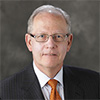Download PDF

By David W. Parke II, MD, Executive Vice President/CEO
The three drivers of change in the American health care system have long been perceived to be cost, quality, and access. Of these three, cost has been widely considered the most significant public policy driver. Quality is often seen as the stepchild by many physicians who individually strive to deliver the highest-quality medicine but who may view public policy initiatives on quality measures as ineffective (or worse) owing to methodologic issues.
Access is emerging as the silent driver that is having a wide halo effect on a host of policies—and it is one to which all ophthalmologists must be sensitive. Stated frankly, concerns regarding access to medical care in general are serving as a convenient blunt instrument to inappropriately impact individual specialties—and influence a range of issues from physician payment to scope of practice.
First, the facts. The Patient Protection and Affordable Care Act extends coverage to more than 30 million Americans. Thanks to the Baby Boomers, between 2010 and 2020 the percentage of the U.S. population who are Medicare beneficiaries will increase by about 27 percent. And seniors average about three to four times as many annual physician visits as nonsenior working-age Americans. In aggregate, multiple manpower projections show that we face an increasing demand for physician services outstripping the supply of physicians. Attempts to increase the supply of ophthalmologists will be too late and require a significant new funding source.
Now, the limitations of the facts. The manpower studies are largely aggregated estimates. Manpower projections for smaller specialties (like ophthalmology) are much less reliable than those for the entire physician population. And all projections are based on current standards of care, delivery models, and technology.
The access issue is now being used as a powerful weapon for non-MD groups seeking to expand their scope of practice—in nursing, pharmacy, optometry, and psychology. And it’s not just at state levels. The House Energy and Commerce Committee unanimously approved a new Medicare physician payment bill that fixes the sustainable growth rate but that also—for the first time—does not require the so-called medical homes to have physicians. These “homes,” which quarterback the overall care of beneficiaries with chronic diseases, may be run by nurses or by physician assistants. Medical homes are a cornerstone of care delivery systems under accountable care organizations.
As far as eye care is concerned, manpower studies have largely been based on a traditional delivery system not reflecting the integrated eye care team that now represents the reality of clinical practice. Nearly 50 percent of Academy members have optometrists in their groups. The percentage of optometrists who work directly with ophthalmologists in an integrated model using technicians, opticians, and other skilled personnel is growing. New technologies, such as patient age-related macular degeneration self-monitoring and inexpensive fundus cameras, will change disease management models.
The fact remains, however, that we, as a profession, must promulgate a solution to the access issues—nationally and locally—or external solutions may be imposed upon us that are not based on facts or science but on perception and politics.